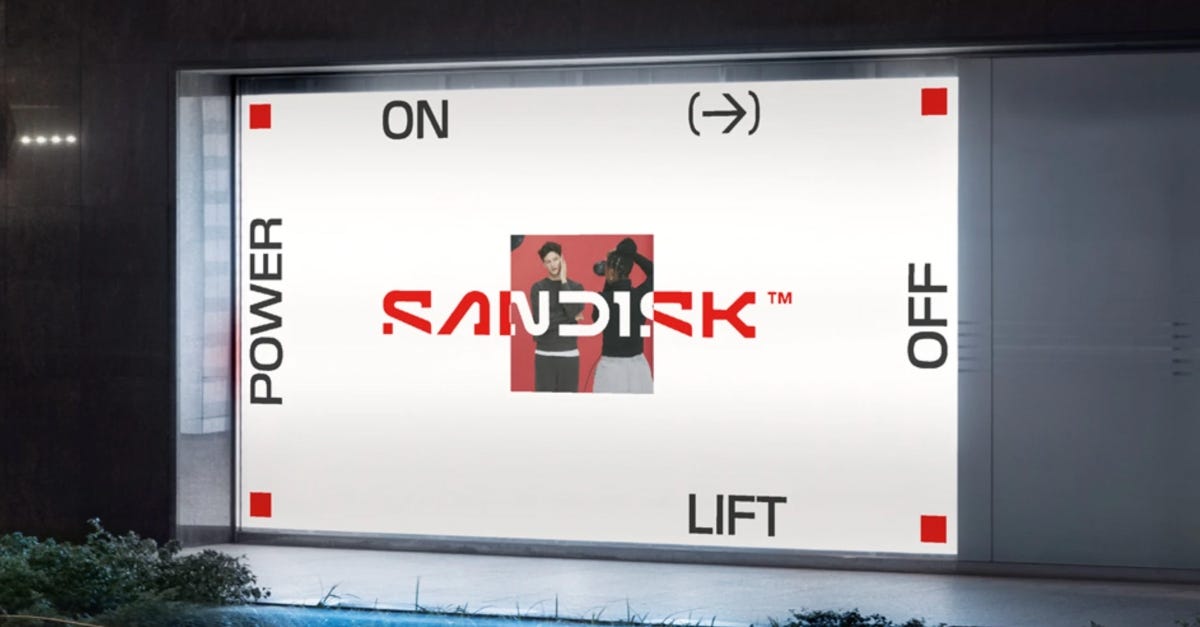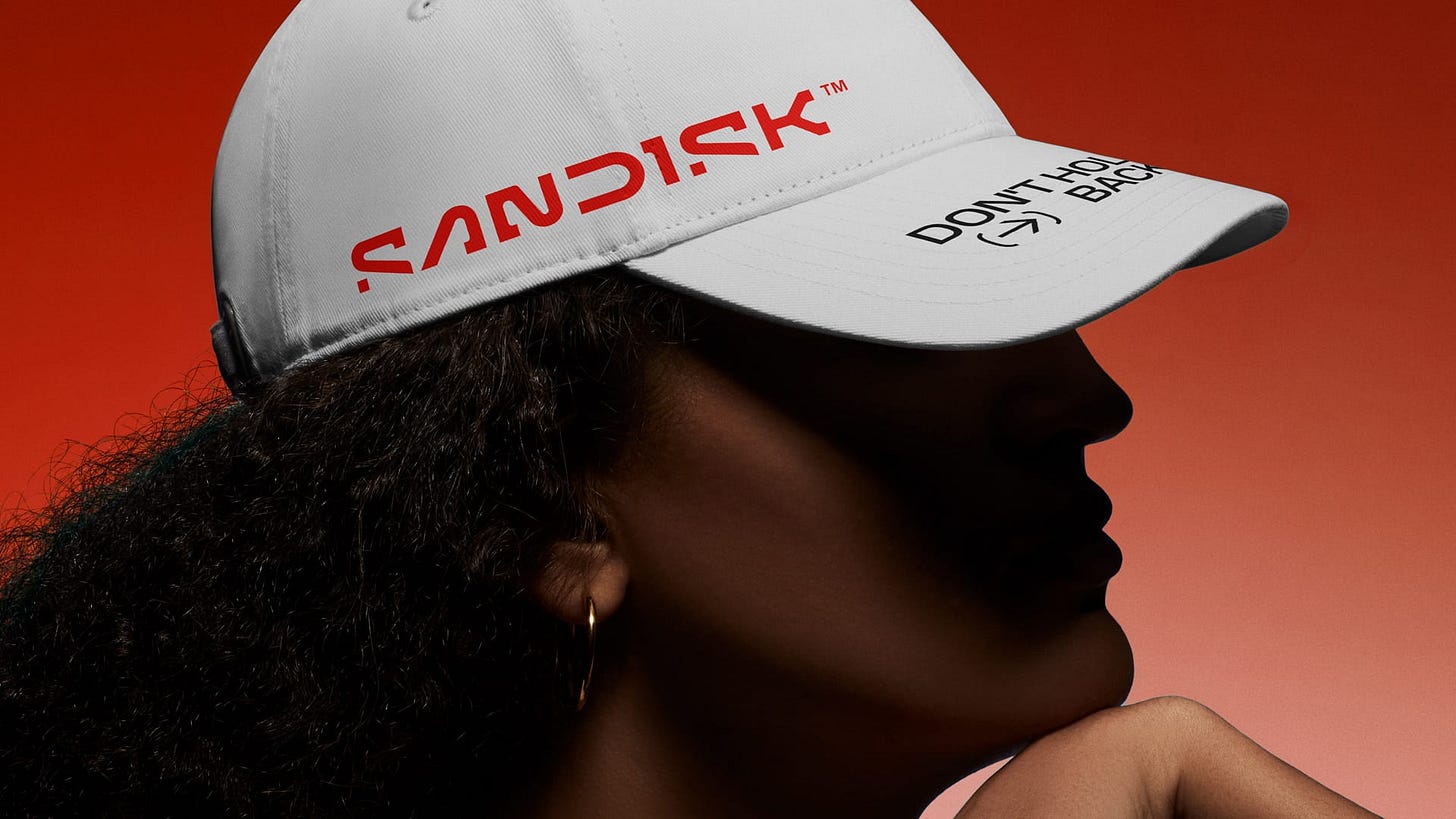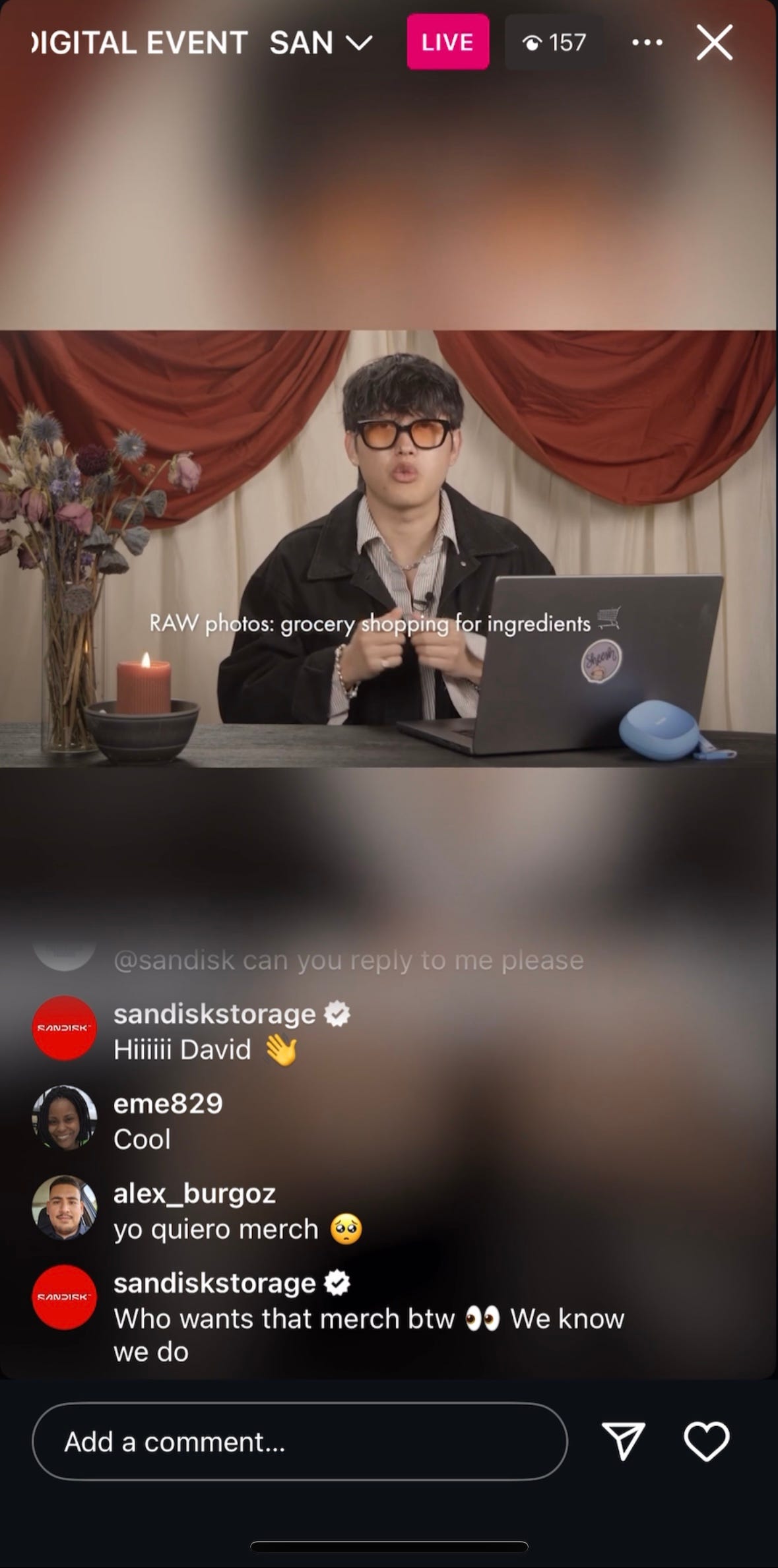#6 Controlled Reinvention: SanDisk’s Rebrand & the Power of Merch as a Growth Engine
Be fluid with your brand; don't be like Kodak.
Happy Friday, Marketers!
This week’s digest is a little long, but it’s worth it. We’re looking at how SanDisk, the OG data storage brand transformed its brand refresh into a multi-touchpoint merch drop; Kaiber AI introduced Kiko as an AI companion with personality; and Pokémon Champions leveraged console nostalgia to deepen its connection with players in NYC. Whether through street pop-ups, AI branding, or gaming crossovers, these brands are proving that the best products don’t just serve a function— they create a feeling, a fluid dialogue of its vibey omni-presence.
Digital transformation is tough, especially for legacy brands that are deeply tied to their original business models like Kodak (we still love Kodak though). But clinging to the past is often more dangerous than embracing change. Sometimes, you have to let go of stagnant strategies, even if they were once successful, and allow innovation to flow—just like water.
SanDisk isn’t radically overhauling its brand; instead, it’s embracing controlled reinvention by strategically adapting to the needs of modern creators. The company offers products that empower motion and progress, while integrating new trends like mobile-first, cloud-compatible solutions, and AI-driven optimization. Through campaigns that highlight the endless potential for creativity, SanDisk became fluid with purpose—reinforcing its position as a key enabler in the creative space, all while ensuring its core values of reliability and performance remain intact.
SanDisk’s Rebrand & the Power of Merch as a Growth Engine
At Hybrid Rituals, we’ve been deep in the intersection of tech, commerce, and community, tracking how brands move beyond transactions to create meaningful, lasting engagement.
One of the biggest unlocks we’ve surfaced? Merch as a strategic growth tool.
Consumer tech brands are no longer just selling products—they’re building communities, cultivating brand identity, and engaging users across multiple touchpoints.
SanDisk’s recent rebrand is a perfect proof point—one that shows just how far a brand can go when merch is more than an afterthought, but an active part of the storytelling.
As SanDisk transitions from being seen solely as a "data storage" company to positioning itself as a brand for creators, the rollout of their rebrand demonstrates the power of merch-driven engagement in amplifying brand transformation.
SanDisk’s Rebrand: A Multi-Touchpoint Campaign
When Sandisk debuted their new pixel-driven logo, they could’ve easily stopped at a slick design update. But instead, they treated this rebrand as a full-scale cultural reset—one that used merch, content, and community-driven activations to reposition the brand.
Public Reactions as a Content Strategy
Before officially dropping the new logo, SanDisk hit the streets of New York City, showing the new design to passersby and capturing real-time feedback. This street-style interview approach wasn’t just about validation—it turned into compelling social content, letting the audience feel involved in the brand’s transformation. They weren’t just testing the waters—they were creating participation. By building the reveal into content, they gave people a reason to care before the launch even happened.
The best brands don’t just present a rebrand—they make it feel like a cultural moment that people can react to, remix, and engage with in real time. By integrating public reactions into their brand reveal, SanDisk built anticipation and social proof, allowing their audience to feel invested in the change.
Creators First: Building A Brand Positioning Beyond Data Storage
A core shift in SanDisk’s new direction is how they’re speaking to artists, designers, and content creators—moving from "We make storage solutions" to "We empower creative work."
To reinforce this, they spotlit a photographer and a designer in their first wave of content—an intentional move to reframe who SanDisk is for and what they stand for.
The best merch doesn’t just rep a brand—it signals an identity. This is why creator-focused merch works so well: it aligns with a shared mindset and aesthetic, not just a product category.
Merch as an Experience: SanDisk’s NYC Pop-Up
Last week, SanDisk brought their merch into the real world, running a surprise NYC street pop-up where random passersby got first access to the collection—before it was even available online.
This wasn’t just a product drop—it was a brand activation designed to:
Create exclusivity & FOMO around the merch
Generate organic UGC & word-of-mouth
Reinforce SanDisk shift into lifestyle branding
After the pop-up, they turned the footage into content, using the street reactions and surprise moments to build even more anticipation for the official merch store launch. Merch launches shouldn’t feel like inventory going live. They should feel like a moment you don’t want to miss.
Merch as a Brand Extension, Not an Afterthought
SanDisk’s merch wasn’t just slapped together— it feels like an intentional extension of their brand aesthetic and creative positioning. Not just a corporate swag dump.
Merch as an Event: The street pop-up wasn’t just about selling merch—it was about turning the drop into a physical, tangible moment. Scarcity + surprise = hype.
Merch as a Content Engine: Every part of this campaign—from the street interviews to the pop-up to the creator spotlights—was turned into shareable, organic content that extended the reach of the rebrand far beyond a single announcement post.Merch as a Community Builder
SanDisk is speaking to creatives now, not just tech consumers. The merch helps reinforce that shift by giving people a way to visually align with the brand’s new ethos. SanDisk’s merch is part of a broader ecosystem aimed at making their audience feel seen and represented.
Reframing merch as more than just an extra revenue stream
At Hybrid Rituals, we’ve been tracking how brands—from tech startups to legacy giants—are reframing merch as more than just an extra revenue stream.
Merch can be an integral part of a brand’s transformation—not just a promotional add-on. The best consumer tech brands are moving toward cultural relevance, not just utility. By treating merch as an experience, brands can create organic demand and deeper consumer engagement.
SanDisk’s approach is a strong proof of concept for how consumer tech brands can use merchandise as a growth engine—one that bridges brand identity, content, and community.
Now that their merch store is live, we’ll be keeping an eye on how they evolve this strategy in the months ahead.
Kaiber AI Launches Kiko, a Artistic AI Companion With A Cutesy AI-Generated Oscars Red Carpet Appearance.
Kaiber.ai’s launch of Kiko, the AI companion marks a shift in how AI tools integrate into creative workflows—not just as utilities but as personified companions. Unlike faceless AI generators, Kiko embodies a thoughtful, intuitive, and artist-friendly persona, making it feel more like a creative partner than just software. This shift aligns with the growing trend of AI mascots becoming brand personalities, bridging function with familiarity. By giving Kiko a distinct identity, Kaiber.ai is not just offering a tool but creating an emotional touchpoint that artists can connect with, making the experience feel more organic and inspiring. Link
Takeaways:
Personification of AI tools makes them more engaging and memorable.
Kiko’s friendly and intuitive persona fosters a stronger emotional connection with users.
A well-branded AI companion can extend beyond software into merchandise, storytelling, and brand identity.
The fusion of functionality and personality sets a new standard for AI-driven creative tools.
Pokémon Champions Revives Console Nostalgia & Competitive Play
Nintendo’s Pokémon Champions announcement taps directly into the growing console nostalgia trend—one we’ve been actively tracking. The ad opens with a montage of Pokémon battles evolving from Game Boy link cables to modern online play, reinforcing how generations of players connect Pokémon not just to the franchise, but to the hardware that shaped their gaming experiences. This approach aligns with a broader push by legacy gaming brands to reignite emotional ties with long-time fans while modernizing their offerings for new audiences. By embracing cross-platform play on Switch and mobile, Nintendo ensures Pokémon Champions feels both nostalgic and current, a balance we’ve seen in other brand repositioning strategies this week. As the gaming industry leans further into hardware nostalgia and communal third spaces, expect more franchises to repackage their history into fresh, playable experiences. Link
Takeaways:
Console nostalgia is an active trend. Brands are increasingly leveraging the emotional connection between players and legacy hardware to reignite interest in classic franchises.
Modernizing nostalgia requires accessibility. Pokémon Champions blends retro aesthetics with cross-platform play, ensuring that long-time fans and new players can engage seamlessly.
Bandai Namco's U.S. Debut: Merging Console Nostalgia with Modern Third Spaces
Bandai Namco, the iconic creator of Pac-Man, has launched its first U.S. Cross Store in Brooklyn's Industry City, seamlessly blending console nostalgia with contemporary retail experiences. The store offers authentic Japanese gaming culture, featuring Gashapon vending machines and classic arcade games like Taiko no Tatsujin, providing visitors with tactile, nostalgic interactions. This initiative aligns with the resurgence of arcades as communal "third spaces," catering to a generation seeking social gaming environments beyond the digital realm. By establishing a physical presence, Bandai Namco not only honors its legacy but also taps into the growing demand for immersive, community-centric experiences. Link
Takeaways:
Arcades as Modern Third Spaces: The resurgence of arcades reflects a desire for physical venues where communities can engage socially, blending nostalgia with contemporary entertainment.
Legacy Brands Reimagining Engagement: By integrating classic gaming elements into new retail formats, legacy brands like Bandai Namco are re-establishing themselves, appealing to both longtime fans and new audiences.
Zapier’s “It’s Not Magic, It’s Zapier” Campaign Demystifies Automation
Zapier’s “It’s Not Magic, It’s Zapier” campaign flips the script on automation, positioning its product as powerful yet practical, rather than an unknowable force. Running across social media, email newsletters, and webinars, the campaign leans into humor to highlight how automation isn’t just for tech experts—it’s an intuitive tool anyone can use.
What makes this framing particularly clever is its subtle nod to the ongoing fascination with mysticism—crystals, horoscopes, and the rise of magical aesthetics in mainstream culture over the past five years. While many brands lean into portals, stars, and mystical visuals to make AI feel like a futuristic force, Zapier takes the opposite approach: demystifying automation and standing on the merit of its technology. In an era where AI tools often feel like black boxes, Zapier is making the case that transparency, usability, and real-world value will define the next generation of automation products. Unfortunately, we can’t track down their TikTok ad but we’re linking some other assets from this ongoing campaign. Link Link2
Takeaways:
Tapping into Mysticism—Without Selling the Myth. By flipping magical aesthetics on their head, Zapier cleverly references cultural trends while reinforcing that automation is practical and accessible.
A Shift Toward Transparency in Tech. As AI products become more mainstream, expect more brands to position themselves as clear, explainable, and results-driven—moving away from the “mystical black box” approach.
Jan Brehm Introduction to Microsoft Excel 1990. This week’s POV is a light blast from the past to one of Microsoft’s early adverts for Microsoft Excel. Can you imagine seeing this on tv?? Never mind the fact you probably had to purchase this separately. Even then, with Personal Laptops still being a niche phenomenon, the target market is clear and so is the humor. Can anyone imagine a 4 minute ad spot in 2025 with no quick cuts or CGI product inserts?
We break down the wins—and the misses—of top consumer tech brands.
Expect deep dives, cultural signals, and community-driven insights that go way beyond the usual GTM playbooks.
Reach out: mo@hybrid-rituals.com
Agency: www.hybrid-rituals.agency
Media Platform: www.hybrid-rituals.com

















